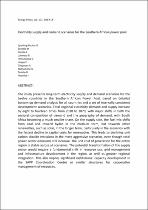JavaScript is disabled for your browser. Some features of this site may not work without it.
- ResearchSpace
- →
- Research Publications/Outputs
- →
- Journal Articles
- →
- View Item
| dc.contributor.author |
Spalding-Fecher, R

|
|
| dc.contributor.author |
Senatla, Mamahloko

|
|
| dc.contributor.author |
Yamba, F

|
|
| dc.contributor.author |
Lukwesa, B

|
|
| dc.contributor.author |
Himunzowa, G

|
|
| dc.date.accessioned | 2017-09-19T08:21:00Z | |
| dc.date.available | 2017-09-19T08:21:00Z | |
| dc.date.issued | 2017-02 | |
| dc.identifier.citation | Spalding-Fecher, R., Senatla, M., Yamba, F. et al. 2017. Electricity supply and demand scenarios for the Southern African power pool. Energy Policy, vol. 101: 403-414. http://dx.doi.org/10.1016/j.enpol.2016.10.033 | en_US |
| dc.identifier.issn | 0301-4215 | |
| dc.identifier.uri | http://dx.doi.org/10.1016/j.enpol.2016.10.033 | |
| dc.identifier.uri | http://www.sciencedirect.com/science/article/pii/S0301421516305845 | |
| dc.identifier.uri | http://hdl.handle.net/10204/9569 | |
| dc.description | Copyright: 2017 Elsevier. Due to copyright restrictions, the attached PDF file only contains the abstract of the full text item. For access to the full text item, kindly consult the publisher's website. | en_US |
| dc.description.abstract | The study presents long-term electricity supply and demand scenarios for the twelve countries in the Southern African Power Pool, based on detailed bottom-up demand analysis for all countries and a set of internally consistent development scenarios. Total regional electricity demand and supply increase by eight to fourteen times from 2010 to 2070, with major shifts in both the sectoral composition of demand and the geography of demand, with South Africa becoming a much smaller share. On the supply side, the fuel mix shifts from coal and toward hydro in the medium term, but towards other renewables, such as solar, in the longer term, particularly in the scenarios with the fastest decline in capital costs for renewables. This leads to declining unit carbon dioxide emissions in the more aggressive scenarios, even though total power sector emissions still increase. The unit cost of generation for the entire region is stable across all scenarios. The potential transformation of the supply sector would require a fundamental shift in resource use, grid management and infrastructure development in the region, as well as greater regional integration. This also implies significant institutional capacity development in the SAPP Coordination Centre or similar structures for cooperative management of resources. | en_US |
| dc.language.iso | en | en_US |
| dc.publisher | Elsevier | en_US |
| dc.relation.ispartofseries | Worklist;19376 | |
| dc.subject | Electricity supply and demand | en_US |
| dc.subject | Southern Africa | en_US |
| dc.subject | Optimisation modelling | en_US |
| dc.subject | Bottom-up demand analysis | en_US |
| dc.title | Electricity supply and demand scenarios for the Southern African power pool | en_US |
| dc.type | Article | en_US |
| dc.identifier.apacitation | Spalding-Fecher, R., Senatla, M., Yamba, F., Lukwesa, B., & Himunzowa, G. (2017). Electricity supply and demand scenarios for the Southern African power pool. http://hdl.handle.net/10204/9569 | en_ZA |
| dc.identifier.chicagocitation | Spalding-Fecher, R, Mamahloko Senatla, F Yamba, B Lukwesa, and G Himunzowa "Electricity supply and demand scenarios for the Southern African power pool." (2017) http://hdl.handle.net/10204/9569 | en_ZA |
| dc.identifier.vancouvercitation | Spalding-Fecher R, Senatla M, Yamba F, Lukwesa B, Himunzowa G. Electricity supply and demand scenarios for the Southern African power pool. 2017; http://hdl.handle.net/10204/9569. | en_ZA |
| dc.identifier.ris | TY - Article AU - Spalding-Fecher, R AU - Senatla, Mamahloko AU - Yamba, F AU - Lukwesa, B AU - Himunzowa, G AB - The study presents long-term electricity supply and demand scenarios for the twelve countries in the Southern African Power Pool, based on detailed bottom-up demand analysis for all countries and a set of internally consistent development scenarios. Total regional electricity demand and supply increase by eight to fourteen times from 2010 to 2070, with major shifts in both the sectoral composition of demand and the geography of demand, with South Africa becoming a much smaller share. On the supply side, the fuel mix shifts from coal and toward hydro in the medium term, but towards other renewables, such as solar, in the longer term, particularly in the scenarios with the fastest decline in capital costs for renewables. This leads to declining unit carbon dioxide emissions in the more aggressive scenarios, even though total power sector emissions still increase. The unit cost of generation for the entire region is stable across all scenarios. The potential transformation of the supply sector would require a fundamental shift in resource use, grid management and infrastructure development in the region, as well as greater regional integration. This also implies significant institutional capacity development in the SAPP Coordination Centre or similar structures for cooperative management of resources. DA - 2017-02 DB - ResearchSpace DO - 10.1016/j.enpol.2016.10.033 DP - CSIR KW - Electricity supply and demand KW - Southern Africa KW - Optimisation modelling KW - Bottom-up demand analysis LK - https://researchspace.csir.co.za PY - 2017 SM - 0301-4215 T1 - Electricity supply and demand scenarios for the Southern African power pool TI - Electricity supply and demand scenarios for the Southern African power pool UR - http://hdl.handle.net/10204/9569 ER - | en_ZA |






